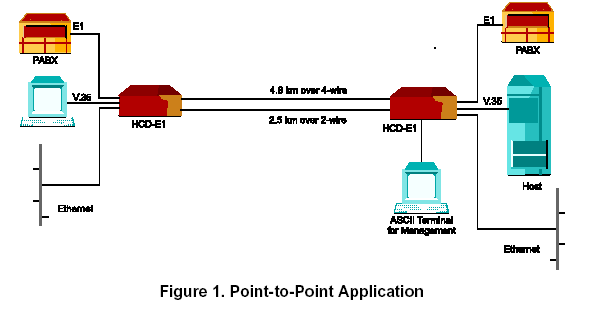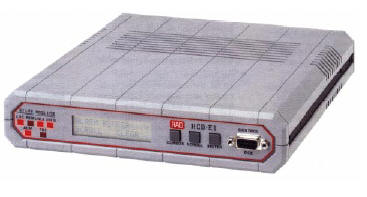FEATURES
- HCD-E1 is an access unit that converts n x 56, n x
64 kbps or fractional or full E1 signals into HDSL transmission format.
The conversion extends the transmission range to cover 4.8 km (3.0 miles)
over a 4-wire link, or 2.5 km (1.6 miles) over a 2-wire link (24 AWG / 0.5
mm) without the need for repeaters or fiber optic link.
- HCD-E1 can be ordered with one or two different
data ports, and with a sub-E1 drop & insert port. The data port rates are
selectable for any multiple of 56 or 64 kbps. The user data of each port
is placed into an E1 frame, using specified timeslots, and then converted
into an HDSL frame. Each timeslot of the sub-E1 port is placed in the same
timeslot as the HDSL E1 frame.
- Transmission of HCD-E1 complies with the ETSI HDSL
standards. The unit compensates for line impairment, bridge taps and mixed
cabling by using equalization technology, adaptive filtering, echo
cancelling and 2B1Q line coding. These factors provide high immunity to
background noise and enable the transmission of multiple HDSL lines over
the same physical cable.
- An embedded channel in the HDSL transmission
provides both control and diagnostic capabilities from a central HDSL
device, up to the remote unit at the customer's premises. The user can
monitor the link and alarms, and perform online configuration, as well as
diagnostic loops to the remote unit.
- HCD-E1 can operate opposite other RAD HDSL
products, such as HTU-E1, HTU-2 and H-RPT. This enables one type of HDSL
equipment to manage another type at a remote location.
- Two data ports are available with the following
interfaces: RS-530, V.35, X.21 and RS-449/V.36. Another ordering option is
a built in Ethernet (10BaseT) bridge, which enables a LAN-to-LAN
connectivity using the HDSL technology. When ordering the Ethernet bridge
option, one of the data ports is the Ethernet connection and the other
data port can be one of the following four types of interfaces: RS-530,
V.35, X.21 or RS-449/V.36.
- Timeslot assignment is programmable, allowing data
from each data port and from the sub E1 port to be placed into timeslots,
either consecutively or alternately. HCD-E1 provides full user control of
the data ports timeslot allocation without restrictions.
- Multiple clock source selection ensures maximum
flexibility for supporting different applications. The main HDSL link may
be clocked from the recovered receive clock, from an internal oscillator,
from one of the data ports or from the sub-E1 port. The data channels may
be set to the following clock options:
- DCE - where the data channel provides both
transmit and receive clocks to the user DTE
- DTE1 - where the data channel provides the
receive clock to the user while receiving the transmit clock from the
user DTE
- DTE2 - where the data channel receives both the
transmit and receive clocks from the user DCE.
- The sub-E1 interface complies with ITU
recommendations G.703 and G.704 and can work with or without CRC-4. HDB-3
zero suppression is used.
- The priority bumping feature allows the user to
select the timeslot priority (high or low) in case one of the HDSL lines
is down.
- Setup, control and monitoring of status and
diagnostics information can be performed using one of the following:
- Front panel LCD with three push buttons, using
menu driven management
- ASCII terminal connected to the async control
port using command line interpreter
- SNMP management station connected to the async
control port, using Serial Link Interface Protocol (SLIP).
- HCD-E1 can be managed via a dedicated E1 or HDSL
timeslot.
- HCD-E1 supports an internal SNMP agent and can be
controlled by any generic SNMP station or by the RADview SNMP network
management application.
- When working opposite an HDSL card in the LRS-12
rack, a direct Ethernet connection is available for central SNMP
management.
- HCD-E1 is available as a standalone unit for
desktop use or for installation in a 19" rack. A rack-mount adapter kit
enables installation of one or two standalone units side by side.
SPECIFICATIONS
- Converts n x 64, n x 56 or full E1 data rates to HDSL transmission
format
- Range of up to 9.2 km (5.7 miles) with H-RPT repeater or up to 4.8 km
(3 miles) without repeater
- Operates opposite RAD's HTU-E1, HTU-2 and H-RPT
- Complies with the ETSI HDSL standards
- Two data ports with the following interfaces: V.35, RS-530,
RS-449/442, X.21, or built-in Ethernet bridge
- Optional sub-E1 drop & insert port for PABX connectivity
- Built-in SNMP agent for standalone and card versions
- Setup, control and monitoring via front panel or ASCII terminal
- Sub-E1 interface complies with ITU G.703, G.704, G.706, G.723 and
G.823
- Supports priority bumping
- 100 alarm records
- Alarm relay activation upon alarm event
- 24 hour storage of network performance monitoring
- Enhanced diagnostics include:
- User-activated local and remote loopbacks
- Integrated BER tester
- Fractional E1 in-band loop
- High voltage line protection in compliance with ITU K.21
HCD-E1/N/*/+/$/&
HDSL E1 Access unit, standalone, with HDSL over 4-wire line
HCD-E1/2W/*/+/$/&
HDSL E1 Access unit, standalone, with HDSL over 2-wire line
| * |
Specify supply voltage
AC for 115 or 230 VAC
48 for -48 VDC
|
| + |
Specify sub-E1 option
(default is without sub-E1)
S1 for sub-E1 interface
|
| $ |
Specify number of ports
1 for one data port
2 for two data ports
|
| & |
Specify digital interface
V35 for V.35 interface
X21 for X.21 interface
530 for RS-530 interface
V36 for RS-449/V.36 interface
UTP for 10BaseT and one data port
BNC for 10Base2 and one data port
|
ORDERING
HCD-E1/N/S1/48/2/V35
HCD-E1/N/S1/AC/2/530
HCD-E1/N/S1/AC/2/V35
HCD-E1/S1/AC/1/V35
HCD-E1/S1/AC/2/530
HCD-E1/S1/AC/2/V35
APPLICATION

|

